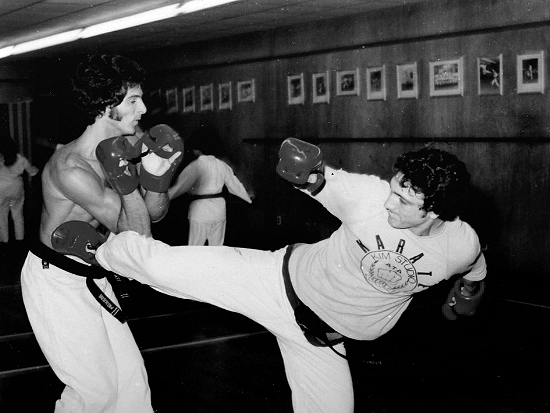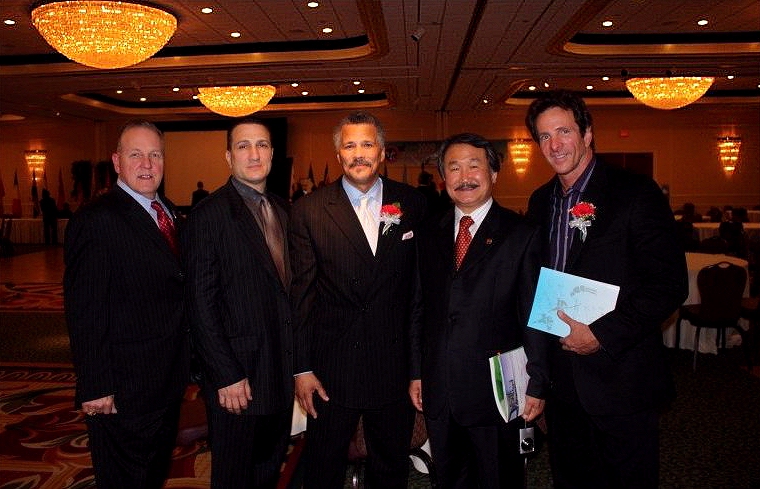"I'll Take Lewis!"
...exclaimed an impatient young George Thanos as he
anxiously awaited his turn to fight. The event was the highly
prestigious Jhoon Rhee
Nationals held in Washington D.C. It was one of the few tournaments
of the time (1960's) that attracted the best
fighters from all parts of the United States. Although the tournament
scene at that time was relatively young, Lewis a former marine who
had
recently returned from overseas duty was an established champion who was
considered by most to be unstoppable. On this day George
would do battle with a man who usually casually walked over his opponents
due to his experience and skill combined with strategy and shear
brute strength.
Mitchell Bobrow
who was the ring coordinator that day complied with Thanos' request and
placed Thanos' name card next to
Lewis' to ensure that the two would meet. Several years before this
article was written this writer asked Taekwondo Hall of Famer Mitchell
Bobrow to name the person who gave him his toughest fight. Bobrow quickly
replied: "Joe Lewis was one of my toughest." "His side
kick was awesome and if he got his hand on the sleeve of your uniform it
was all over!"
As Thanos and Lewis stood face to face before the match began most probably
thought Thanos would become yet another sad statistic.
However on this day the scenario would be totally different. George
Thanos who barely 17 years old exhibited confidence, poise and fighting
skills that belied his age and youthful appearance. The proof
is in the article attached which appeared in
Black Belt magazine.
The article
indicates that it was Thanos who was the total aggressor during the match,
putting the great Joe Lewis on the run!. Before and during the
match
George appeared to be oblivious to Lewis or his record of victories with
an arsenal of techniques that included powerful hand techniques
and his
devastatating trademark side kick. In the end Lewis would be awarded
the match but only by scoring a point as time was running out and pro-
tecting his lead by running from a relentless, young George Thanos.
Reading the blow by blow description of the match one might get the
impression that observers who had followed Lewis's career were left shaking
their heads in disbelief at the end of the match as a result of the
antics displayed by Lewis.
The scenario above is not so surprising when you consider that George's
instructor was the great Grand Master Ki Whang Kim (1920-1993).
The Kim Studio located in Silver Spring Maryland churned out some of the
best compettitors n the U.S. such as Mike Camberiate, Neil Ehrlich,
Larry Stone, Wendell Robinson, Ralph Nelson, Bill Keefer, Mitchell Bobrow,
Albert Cheeks, Mike Warren, Keith Yarlboro, Marcella Byrd,
Jim Roberts Jr. the perennial forms champion in the early days and John Critzos
who arrived later on the scene.

George Thanos training with
Mitchell
Bobrow
George Thanos' career as a fighter extended from the 60's into the 70's where
he won numerous events including the
All American Open in
1975 held at Madison Square Garden in New York City perhaps the most prestigious
tournament of the time. Winning grand championship
of the All American when it was held "The Garden" in the 70's was the
zenith achievement of a champion's career.
George began his martial arts training at Kim Studio in Silver Spring Maryland
in 1965 at the age of 13. He was personally instructed by Ki
Whang Kim and rtceived his black belt in Moo Duk Kwan Tang Soo Do in 1966.
In 1975 George operated and taught at the Tae Kwon Do
Moo Duk Kwan of America Inc.- Kim Studio of Karate in Myrtle Beach, South
Carolina. During the 70's Karate Illustrated Magazine nick-
named George "gray ghost" due to his light skin tone. His opponents
took heed to the meaning of George's last name "Thanos" which means
"death" in the traditional Greek language. During the 70's George won
victories over several champions including Joseph Hayes, Alan Miller,
Flem Evans, Wayne VanBuren, jaquet Bazemore,
Gerard Robbins and
Adolpho Velasco. He defeated Louis Delgado twice in the same day.
George has been referenced in numerous martial arts publications including
the"Original Martial Arts Encyclopedia" by John Cocoran and
Emil Farkas with Stuart Sobel, the "Official History of Karate
in America - The Golden Age" (1968) by Al Weiss and David Weiss,
and
"Who's Who in Martial Arts Directory of Black Belts " by Bob
Wall (1975). He earned the distinction of being
chosen to compete as
one of 50 fighters in the newly formed Professional Karate Association during
which time he held a PKA World rating in the Light-Heavyweight
division.
George's best contribution to the martial arts is his 15 years of fighting
ability in tournaments as n very aggressive and exciting fighter.
George
utilized only the finest techniques which thrilled the spectators. In 2008,
after 43 years of involvement in the martial arts George continues to
train. He continues to operate the family business which is the
largest drycleaning / laundry facility in Washington D.C. |

